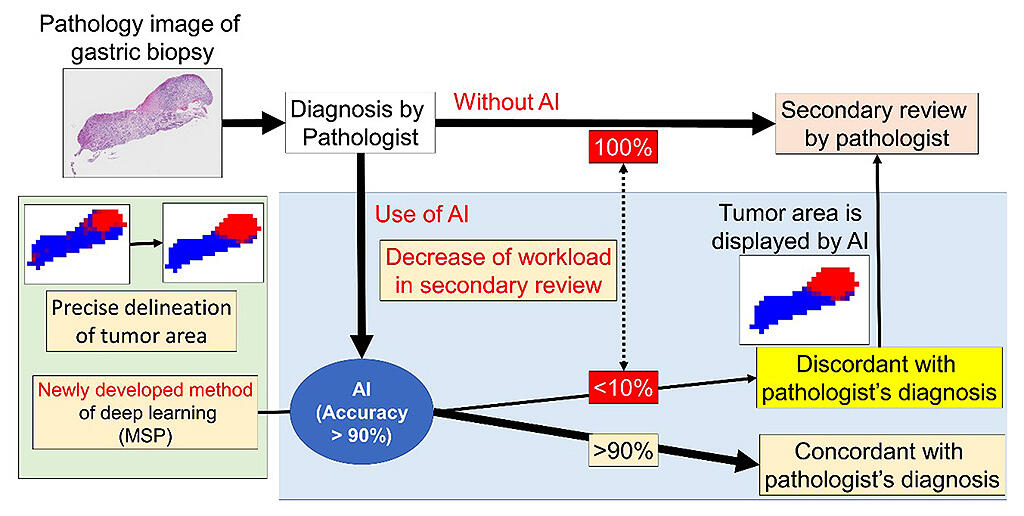The Japanese Society of Pathology (JSP) and the National Institute of Informatics (NII), with support from the Japan Agency for Medical Research and Development (AMED), and in collaboration with the University of Tokyo, have developed an AI to assist with pathological diagnosis in gastric biopsies, in which the stomach is observed through an endoscope to collect mucosal tissue from areas suspected of having a lesion. The intent of this is to support pathologists, who are chronically in short supply, and reduce their workload by using this AI to double-check pathology diagnoses. And by incorporating it into a telepathology diagnosis network, it is anticipated to overcome disparities in cancer treatment so that standardized specialized cancer care can be provided anywhere in Japan. The results of this study were published on August 12 in Cancer Science, the international journal of the Japanese Cancer Association.

Provided by The Japanese Society of Pathology
The image recognition AI can detect abnormalities in ultra-high-resolution microscopic digital images and makes use of the multi-stage semantic segmentation for pathology (MSP) method, a newly developed method of deep learning. This AI effectively determines the presence of a tumor and pinpoints the location on the image.
The MSP method is a machine learning method newly developed by the laboratory of Professor Tatsuya Harada (NII visiting professor) of the Research Center for Advanced Science and Technology, the University of Tokyo. Since the MSP method extracts features from finely segmented individual patch images and also learns the distribution of features in the original pathology image, machine learning can be performed without losing the positional information of patches of the entire image in a greatly compressed form of the pathology image.
This support AI for pathology diagnosis, developed by machine learning using the MSP method, was able to correctly determine the entirety of a noncancer case as noncancerous, even if there were scattered patches that showed false positives by conventional methods. In determining cancer versus non-tumor, the MSP method achieved a 94.8% agreement rate (internal data set) with the pathologist's diagnosis.
The results were also 94.6% ± 2.3% (minimum 90.4%, maximum 97.4%) in the external data set of 10 centers, which was superior to the conventional method. This demonstrates that the MSP method is a stable method that is less susceptible to inter-institutional variations when applied to multiple facilities.
Although pathological diagnosis with a microscope by a pathologist is essential to confirm a diagnosis of cancer, there is currently a shortage of pathologists in Japan, with only one full-time pathologist at about 300 of the approximately 700 hospitals with such staff. Pathologists working under these circumstances are at risk of missing or over diagnosing cancer because it is difficult for them to double-check their own diagnoses by having another pathologist check and confirm their results by observing them under a microscope.
This achievement is the joint result of the Japan Pathology AI Diagnostics Project (JP-AID), an AMED-commissioned project started in 2017 by the JSP, and the Medical Big Data Research Center (RCMB), which was established by the NII in the same year as an AMED-commissioned project to develop and operate a cloud infrastructure to promote the use of medical big data. The two parties aim to obtain regulatory approval for the developed AI as a programmed medical device in order to introduce AI in support of pathological diagnosis into the medical field in the future. In addition, an AI to support pathological diagnosis other than gastric biopsies is also under development.
Preparations are also underway to release the digital histopathology images of various organs collected through the JP-AID project as the "Digital Image Database of the Japanese Society of Pathology" so that they can be used for AI development.
This article has been translated by JST with permission from The Science News Ltd.(https://sci-news.co.jp/). Unauthorized reproduction of the article and photographs is prohibited.




